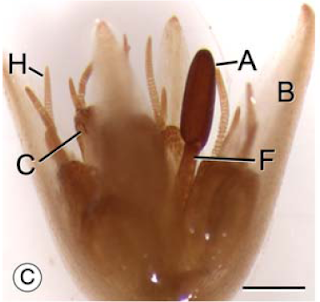 Here's a not very awesome image of a "flower" of Trithuria submerse (Hydatellaceae). As the name suggests this is a monogeneric family of small, aquatic "grassy" plants that were long classified as monocots. The word flower is in quotes because like some of the oldest fossils of flowers, e.g. Archaefructus, it brings into question what should be called a flower. In this case what you actually see is best referred to as a "reproductive unit", which can vary in the number and ratio of subunits, in this case consisting of 4 simple pistillate flowers (C = carpel; H = stigmatic hair) each associated with a bract (B), a modified leaf, surrounding a single stamen/flower (A-anther, F-filament)(Bar = 0.5 mm). The morphological features do not suggest any close relationships, but molecular data surprised everyone by showing them to be a sister group to the waterlilies (Nymphaeaceae) and part of one of the basal lineages of flowering plants, those plants that have the most ancient common ancestry with the rest of angiosperms. These basal lineages are referred to as the ANA grade where the N stands for waterlilies now including this little vestigial (?) waterlily. The image is compliments of a recent study of the reproductive ecology which find that mostly it self pollinates, probably a mechanism for rapid reproduction in its ephemeral shallow-water habitat. That such plants look monocoty is not a surprise; basal angiosperms, basal monocots, and magnolid dicots all tend to have flowers with parts in multiples of 3s and often numerous. Others are very few-parted and simple. Water lilies also have only one cotyledon, but remember that several gymnosperms also have 2 cotyledons, so this sure does mess up the old traditional monocot-dicot taxonomy. The Phactor will save that lesson for another time.
Here's a not very awesome image of a "flower" of Trithuria submerse (Hydatellaceae). As the name suggests this is a monogeneric family of small, aquatic "grassy" plants that were long classified as monocots. The word flower is in quotes because like some of the oldest fossils of flowers, e.g. Archaefructus, it brings into question what should be called a flower. In this case what you actually see is best referred to as a "reproductive unit", which can vary in the number and ratio of subunits, in this case consisting of 4 simple pistillate flowers (C = carpel; H = stigmatic hair) each associated with a bract (B), a modified leaf, surrounding a single stamen/flower (A-anther, F-filament)(Bar = 0.5 mm). The morphological features do not suggest any close relationships, but molecular data surprised everyone by showing them to be a sister group to the waterlilies (Nymphaeaceae) and part of one of the basal lineages of flowering plants, those plants that have the most ancient common ancestry with the rest of angiosperms. These basal lineages are referred to as the ANA grade where the N stands for waterlilies now including this little vestigial (?) waterlily. The image is compliments of a recent study of the reproductive ecology which find that mostly it self pollinates, probably a mechanism for rapid reproduction in its ephemeral shallow-water habitat. That such plants look monocoty is not a surprise; basal angiosperms, basal monocots, and magnolid dicots all tend to have flowers with parts in multiples of 3s and often numerous. Others are very few-parted and simple. Water lilies also have only one cotyledon, but remember that several gymnosperms also have 2 cotyledons, so this sure does mess up the old traditional monocot-dicot taxonomy. The Phactor will save that lesson for another time.
Change of address
5 months ago in Variety of Life
















No comments:
Post a Comment